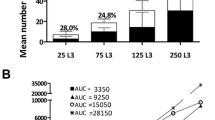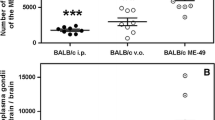Abstract
Subcutaneous injections of intrauterine stages ofLitomosoides carinii intoMastomys natalensis induced strong immunity to i.v. injected blood microfilariae. Immunity, developed after boostering with an i.p. and an i.v. injection of microfilariae, did not totally suppress the parasitaemia of a challenge infection but reduced significantly the microfilaraemia level. No effect was found on number and size of the worms of the challenge infection, the number of microfilariae or the number of leucocytes in the pleural cavity. Delayed type hypersensitivity reactions in challenged animals were similar to those in non-immunized, infected controls.
Sera of immunized animals agglutinated microfilariae and mediated cell attachment to microfilariae. Challenge infections did not change this until the end of the fourth week post infection but sera taken 32 days after challenge and later failed to induce such reactions. Challenge infections performed 120 or 240 days after a primary infection did not increase the parasitaemia of recipients. Dissections carried out 130 days after the challenge showed that (a) the developmental rate of the challenge infection was reduced by about 50%; (b) the size of the challenge parasites was reduced; and (c) that these worms produced significantly less embryonic stages in comparison to worms of primary infections, of which about 90% were abnormal.
Similar content being viewed by others
References
Ah HS, Peckham JC, Mitchell FE, Thompson PE (1972) Studies onDirofilaria immitis infection in dogs. Relative to immunizations and antigen-antibody interactions. In: Bradley RE (ed) Canine heartworm disease. The current knowledge. University of Florida Press, Gainesville, p 55
Bagai RC, Subrahmanyam D (1970) Nature of acquired resistance to filarial infection in albino rats. Nature 228: 682–683
Bertram DS (1953) Laboratory studies on filariasis in the cotton rat. Trans Roy Soc Trop Med Hyg 47: 85–106
Bertram DS (1966) Dynamics of parasitic equilibrium in cotton rat filariasis. Adv Parasit 4: 255–319
Denham DA (1980) Vaccination against filarial worms using radiation-attenuated vaccines. Int J Nucl Med Biol 7: 105–111
Denham DA, Ponnudurai T, Nelson GS, Rogers G, Guy F (1972) Studies withBrugia pahangi. II. The effect of repeated infection on parasite levels in cats. Int J Parasit 2: 401–407
Denham DA, McGreevy PB, Suswillo RR, Rogers R (1983) The resistance to reinfection of cats repeatedly inoculated with infective larvae ofBrugia pahangi. Parasitology 86: 11–18
Haas B, Wenk P (1981) Elimination of microfilariae (Litomosoides carinii Filaroidea) in the patent and in the immunized cotton rat. Trans Roy Soc Trop Med Hyg 75: 143–144
Haque A, Lefebvre, MN, Ogilvie BM, Capron A (1978)Dipetalonema viteae in hamsters: effect of antiserum or immunization with parasite extracts on production of microfilariae. Parasitology 76: 61–75
Jaquet J (1980)Litomosoides carinii (Travassos 1919) Chandler 1913 (Filaroidea) in cotton rats (Sigmodon hispidus, Say et Ord 1825) and jirds (Meriones unguiculatus, Milne-Edwards 1867): comparison of the infection in relation to the immune response. Thesis; Faculty of Science of the University of Neuchâtel, Switzerland
Kimmig P, Braun U (1980) Die Isolierung von Mikrofilarien vonLitomosoides carinii im Ficoll-Dichtegradienten. Z Parasitenkd 63: 711–715
Kimmig P, Wenk P (1982) Unterdrückung der Parasitämie bei der Nagetierfilariose (Litomosoides carinii) durch Immunisierung mit BCG und Mikrofilarien. I. Intrakutane Applikation von BCG. Z Parasitenkd 67: 317–327
Klei TK, McCall JW, Malone JB (1980) Evidence of increased susceptibility ofBrugia pahangi infected jirds (Meriones unguiculatus) to subsequent homologous infections. J Helminthol 54: 161–166
Kowalski JC, Ash LR (1975) Repeated infections ofBrugia pahangi in the jird,Meriones unguiculatus. Southeast Asian J Trop Med Publ Health 6: 195–198
Lämmler G (1977) Experimental chemotherapy and chemoprophylaxis of filariasis. Pestc Sci 8: 563–576
Lämmler G, Saupe E, Herzog H (1968) Infektionsversuche mit der BaumwollrattenfilarieLitomosoides carinii beiMastomys natalensis (Smith 1834) Z Parasitenkd 32: 281–290
Mehta K, Subrahmanyam D, Sindhu RK (1981) Immunogenicity of homogenates of the developmental stages ofLitomosoides carinii in albino rats. Acta Tropica 38: 319–324
Neilson JTM, Forrester DJ (1975)Dipetalonema viteae in hamsters: the dynamics of primary, secondary and tertiary infections. Exp Parasit 37: 367–372
Raether W, Meyerhöfer W (1967) Quantitative Untersuchungsmethoden zum Nachweis von Mikrofilarien (Litomosoides carinii) mit Hilfe der Zählkammern nach Fuchs-Rosenthal und Jessen sowie Anreicherungsverfahren. Tropenmed Parasit 18: 99–108
Sachs L (1978) Angewandte Statistik, statistische Methoden und ihre Anwendung. Springer Verlag, Berlin Heidelberg New York
Schuster J, Lämmler G, Rudolph R, Zahner H (1973) Pathophysiologische und toxikologische Aspekte bei derSchistosoma mansoni-Infektion derMastomys natalensis. Tropenmed Parasit 24: 487–499
Seiler FR, Sedlacek HH, Kanzy EJ, Lang W (1972) Über die Brauchbarkeit immunologischer Nachweismethoden zur Differenzierung funktionell verschiedener Lymphozyten: Spontanrosetten, Komplementrezeptorrosetten und Immunglobulinrezeptoren. Behring Inst Mitt 52: 26–72
Storey DM, Al-Mukhtar AS (1982) Vaccination of jirds,Meriones unguiculatus, againstLitomosoides carinii andBrugia pahangi using irradiated larvae ofL. carinii. Tropenmed Parasit 33: 23–24
Storey DM, Mettias EF (1980) Suppression of microfilaraemia inLitomosoides carinii infections in cotton rats by vaccination with adult worm homogenate. Ann Trop Med Parasit 74: 211–218
Tandon A, Zahner H, Sänger I, Müller H-A, Reiner G (1983) Time courses of antibody levels inMastomys natalensis after infections withLitomosoides carinii, Dipetalonema viteae, Brugia malayi orB. pahangi, determined by ELISA. Z Parasitenkd 69: 681–692
Tanner M, Weiss N (1981),Dipetalonema viteae (Filaroidea): development of the infective larvae in micropore chambers implanted into normal, infected and immunized jirds. Trans Roy Soc Trop Med Hyg 75: 173–174
Townson S, Bianco AE (1982a) Immunization of calves against microfilariae ofOnchocerca lienalis. J Helminthol 56: 297–303
Townson S, Bianco AE (1982b) Experimental infection of mice with the microfilariae ofOnchocerca lienalis. Parasitology 85: 283–293
Wegerhof PH, Wenk P (1979) Studies on acquired resistance of the cotton rat against microfilariae ofLitomosoides carinii. I. Effects of single and repeated injections of microfilariae. Z Parasitenkd 60: 55–64
Wegerhof PH, Lämmler G, Sänger I, Zahner H (1979) Chemotherapeutic studies inLitomosoides carinii infection ofMastomys natalensis. 8. The action of furazolidone on adult worms and microfilariae. Tropenmed Parasitol 30: 376–382
Weiss N (1970) Parasitologische und immunbiologische Untersuchungen über die durchDipetalonema viteae erzeugte Nagetierfilariose. Acta Tropica 27: 219–259
Wenk P, Illgen B (1979) Neutralization of immunity against microfilariae of the rodent filariaLitomosoides carinii. Naturwissenschaften 66: 626–627
Wenk P, Wegerhof PH (1982) Studies on the acquired resistance of the cotton rat against microfilariae ofLitomosoides carinii. 2. Injection of microfilariae during prepatency. Z Parasitenkd 68: 321–329
Wong MM (1964) Studies on microfilaraemia in dogs. II. Levels of microfilaraemia in relation to immunologic responses of the host. Am J Trop Med Hyg 13: 66–77
Yoeli M (1957) Observation on agglutination and thigmotaxis of microfilariae inbancrofti filariasis. Trans Roy Soc Trop Med Hyg 51: 132–136
Yutuc LM (1959) Agglutination of microfilariae in the blood of the dog infected withDirofilaria immitis. Proc Int Congr Trop Med Malaria (6th), vol 2: 484–487
Zahner H, Wegerhof PH (1985) Immunity toLitomosoides carinii inMastomys natalensis: II. Effects of chemotherapeutically abbreviated and postpatent primary infections on challenges with various stages of the parasite (Submitted)
Zahner H, Lämmler G, Schütze H-R (1980) The use ofMastomys natalensis in experimental parasitology. South African Cancer Bull 24: 278–287
Zahner H, Reiner G, Pries M, Kapmeyer W (1985) Levels of circulating antigens, circulating immune complexes and total antibody levels in the course of experimental filarial infections (Litomosoides carinii, Dipetalonema viteae, Brugia malayi, B. pahangi) ofMastomys natalensis. Submitted
Author information
Authors and Affiliations
Rights and permissions
About this article
Cite this article
Zahner, H., Wegerhof, P.H. Immunity toLitomosoides carinii inMastomys natalensis . Z. Parasitenkd. 71, 583–593 (1985). https://doi.org/10.1007/BF00925591
Accepted:
Issue Date:
DOI: https://doi.org/10.1007/BF00925591




